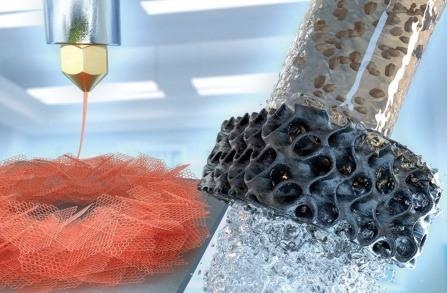
This illustration depicts, at the left, a 3D printer printing the hexagonal-shaped graphene aerogel sheet. At the right, the aerogel (now black) filters dirty water. Credit: Environmental Science: Nano
Access to clean drinking water is a major problem for as much as a third of the world's population. Now, a new combination of graphene, aerogels and 3D printing could provide a solution.
With an increasing global population, the need for clean, accessible drinking water is growing. Graphene has long been suggested as a material that is ideal for the filtration of water and the removal of contaminants.
Unfortunately, while its potential is clear, as of yet, researchers have thus far failed to develop a way to graphene-based water filtration commercially viable. This is due to difficulties associated with scaling up the production of such materials and creating a treatment method that can be reused. That could be a situation that is about to change.
Researchers from the University of Buffalo have developed a new 3D printing method that can construct graphene-based aerogels. The new aerogel helps address those most pressing issues, thus providing a scalable graphene-based filtration process that can be used multiple times.
The goal is to safely remove contaminants from water without releasing any problematic chemical residue. The aerogels we've created hold their structure when put in water treatment systems, and they can be applied in diverse water treatment applications.
Nirupam Aich, Assistant Professor, Environmental Engineering, School of Engineering and Applied Sciences, The University of Buffalo
Alongside lead author Arvid Masud, and Chi Zhou, University of Buffalo associate professor of industrial and systems engineering, Aich is the co-author of a study¹ detailing the team's research published in the journal Environmental Science: Nano as part of the Emerging Investigator Series.
A Lightweight Union
Bringing together graphene and aerogel seems like a match made in heaven for tasks that require a tough but lightweight material.
Graphene is a one-atom-thick sheet of carbon allotropes carved from graphite. The fact that it is one atom thick obviously makes it an incredibly light material, but how these atoms are arranged in a hexagonal lattice also gives it impressive tensile strength.
Aerogel is a highly porous solid made when the liquid in a gel is replaced with a gas resulting in a structure that is unchanged in size but becomes incredibly light.
For the team's graphene-based ink to be used in the laser printing process the researchers also took some inspiration from nature. To the ink, they added two polymers similar to natural substances — polydopamine (PDA) which resembles secretions made by mussels, and bovine serum albumin (BSA), a protein derived from cows.
When the team tested their specially designed aerogel, they found that it could efficiently filter out heavy metals like lead and chromium, organic dyes, and solvents like hexane, heptane, and toluene.
To demonstrate the aerogel's potential for reusability, the scientists ran the solvents through it 10 times, finding that it removed 100% of them each time, even on the tenth pass-through.
Similar testing with the organic dye methylene blue revealed that the aerogel's ability to filter it was reduced by 2–20% by the third pass.
The Global Problem of Clean Accessible Water
In 2019 a report produced by the WHO/UNICEF Joint Monitoring Programme (JMP) for Water Supply, Sanitation, and Hygiene² the joint committee suggested that up to 1 in 3 people do not have access to clean drinking water.
That is clearly a problem of tremendous scale. Fortunately, the filtering mechanism suggested by the team is viable for scaling up to match the size of the problem it is designed to address.
Aich says that because aerogels can be printed at a large scale, something that materials scientists have struggled to do with nanosheets of graphene. This means that their mechanism could be used in wastewater treatment plants and other large-scale water filtration operations.
Not only that but the fact the aerogel is reusable means that the filter can be removed and redeployed in another area, not leaving behind any residues.
We can use these aerogels not only to contain graphene particles but also nanometal particles which can act as catalyst. The future goal is to have nanometal particles embedded in the walls and the surface of these aerogels and they would be able to degrade or destroy not only biological contaminants but also chemical contaminants.
Nirupam Aich, Assistant Professor, Environmental Engineering, School of Engineering and Applied Sciences, The University of Buffalo
References
1. Masud. A., Zhou. C., Aich. N., [2021], 'Emerging investigator series: 3D printed graphene-biopolymer aerogels for water contaminant removal: a proof of concept,' Environmental Science: Nano, [https://pubs.rsc.org/en/content/articlelanding/2021/EN/D0EN00953A#fn1]
2. 'Progress on drinking water, sanitation and hygiene: 2000–2017: Special focus on inequalities,' WHO/UNICEF Joint Monitoring Programme (JMP) for Water Supply, Sanitation, and Hygiene, [2019], [https://www.unicef.org/reports/progress-on-drinking-water-sanitation-and-hygiene-2019]
Disclaimer: The views expressed here are those of the author expressed in their private capacity and do not necessarily represent the views of AZoM.com Limited T/A AZoNetwork the owner and operator of this website. This disclaimer forms part of the Terms and conditions of use of this website.